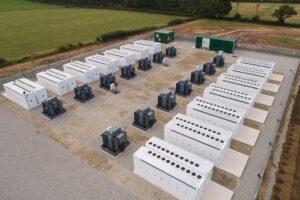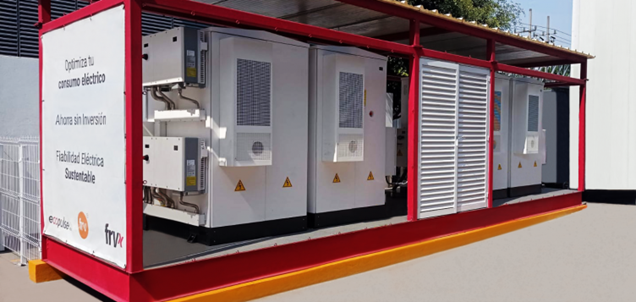Abdul Latif Jameel Energy’s FRV charging ahead in Mexico
As the flagship renewable energy business of Abdul Latif Jameel, and part of Abdul Latif Jameel Energy, Fotowatio Renewable Ventures (FRV) already has a strong pedigree of expansion and innovation.
Active on five continents, FRV’s solar power and energy storage experts have developed 50+ renewable energy plants worldwide, managing a portfolio of more than 2.5 GW in solar markets across Australia, Europe, the Middle East, India, Africa, USA and Latin America. These include a hybrid development in Chile, where a combined solar-wind project has the potential to supply almost 250,000 homes with clean energy, all year round.
It is also developing a different kind of hybrid plant at Dalby in Queensland, Australia. This combines 2.4 MW of photovoltaic solar power generation and 2.5 MW /5MWh of co-located battery storage. It is FRV’s first hybrid project in the country and one of the first battery energy storage system projects in Queensland.

Utility-scale battery energy storage like that being deployed at Dalby is a rapidly growing sector of the energy supply market, and one where FRV and its dedicated innovation arm FRV-X are at the forefront.
In September 2021, FRV-X embarked on its third utility-scale battery storage project, at Clay Tye, Essex, UK, developed in partnership with Harmony Energy. At 99 MW/198 MWh, it is the biggest battery energy storage system under construction in the UK. Clay Tye builds on the success of previous FRV-X battery storage projects in the UK – the 34 MW Contego project in West Sussex incorporates a system of 28 Tesla Megapack lithium-ion batteries.
Meanwhile, the 7.5 MW battery plant at Holes Bay, Dorset, stores energy from the UK National Grid to provide flexibility to supplies during peak hours, contributing to network stability and supporting Britain’s decarbonization plan.
The latest innovative project to showcase FRV’s market-leading expertise in advanced battery storage technologies is in Mexico, where it has partnered with Energy Toolbase, an energy software company, and the Mexican developer Ecopulse, to develop and deploy energy storage projects under an innovative ‘Energy Storage-as-a-Service’ (EnSaaS) model focused on the industrial sector.

It has a nominal power of 480 kW to provide up to two hours of stored energy, allowing industrial clients in Iztapalapa to optimize energy consumption without interfering in production, generating savings on the electricity tariff without incurring any capital investment or associated operating costs. The new Battery Energy Storage System (BESS) will be located in the industrial center of Iztapalapa, in the heart of Mexico City.
FRV is already the second-largest developer of renewable energies in Mexico, with nearly 1 GW of photovoltaic projects in operation. This is its first major energy storage project in the country, however, and it lays the foundation for the further expansion of this EnSaaS model across Mexico and further afield.

Managing Director
FRV Mexico and Central America
We spoke to Felipe Hernández, Managing Director, FRV-X, and Alejandro Limón, Managing Director Mexico and Central America, FRV, about the Iztapalapa project, and its significance for the Mexican energy market.
How long have FRV and FRV-X been operating in Mexico?
AL: FRV opened its office in Mexico in around 2012, just as the Government was starting to open up the industry to foreign and private investment.
Since then, we have been growing our business in the country as a solar PV developer.
Mexico is the second-largest PV generator in the world, with almost 700 MW in operation, so there is huge potential for us here.
FH: FRV-X formally started operating here in 2020 and started our first project in 2021. We hope this latest EnSaaS project is a model that we can roll-out in other locations across Mexico and elsewhere in the region.
Why does an industrial zone like Iztapalapa need a dedicated energy solution like this?
AL: It’s not only Iztapalapa that can benefit from something like this. It could work just as well for virtually the whole country. The reason we have focused on industry to start with is because they are big energy consumers.
Industrial consumers pay a very high cost for the energy they use during peak hours. On average, as much as 40% of their energy bill comes from consumption during just a couple of hours in the middle of the day. Our solution is to install a lithium-ion battery on their premises, a ‘behind the meter’ solution.
This stores up energy during off-peak hours when there is less demand and the cost is lower, and then discharges the energy to the business during the expensive peak hours. This not only reduces costs for the client, but it also reduces the pressure on the grid when demand is at its highest, helping to stabilize the network.
What makes this such an attractive model for businesses?

Managing Director, FRV-X
FH: Energy is a very complex business. Most industrial clients and commercial clients that could benefit from this kind of solution lack the specialist knowledge or manpower to operate these kinds of assets themselves.
With our EnSaaS solution, we put in the investment and the technology, we operate it, commission it and do all the necessary implementation and administration to keep the system running, so they can focus on their core business.
There is no downside for the client. We do it all ourselves. We reduce their energy bill and then share the savings and let them get on with running their company.
The very worst-case scenario is they don’t make the savings expected, but it hasn’t cost them anything. This is what differentiates our service from other models where the client needs to invest the time and money to implement their own battery storage solution.
Is it suitable for any size of business?
FH: I think most businesses could benefit from this scheme. As long as their energy consumption is about 100 kW or more, which is most industrial companies, they would make significant savings.
AL: Yes, more or less any industrial business would benefit. And the higher their energy consumption, the bigger their savings would be. Maybe if it was a business that only used energy during off-peak periods, like at night, it would not be such an attractive position, but most businesses are not like that.
It’s not only about cost savings. It’s also about energy efficiency and production optimization. In some cities in Mexico, energy prices are so high that industrial businesses have to shut down at peak hours in the middle of the day because the cost of production is too high. There are also factories in Europe that operate at night to avoid sky-high day-time energy costs.
Our EnSaaS solutions avoids this and ensures businesses can operate more efficiently and more consistently the whole day, without these kinds of requirements to shut down during peak hours.
Why is it important for you to work with partners like Energy Toolbase and Ecopulse?
FH: They are two different kinds of partners. Energy Toolbase is a software company specializing in the energy sector. We need a smart software system, based on machine learning and artificial intelligence, to manage our solution effectively. This is what Energy Toolbase provides. We use their smart energy management system to manage and maintain battery performance to ensure we generate maximum savings.
Ecopulse is our local EPC partner. They are the ones who install and implement the projects, who act as the link between FRV and the customer. Both partners play a very important role in the success of this project.
Now you’ve launched this first project in Mexico City, do you expect to expand it further in Mexico and into other countries?
AL: Yes, we have an ambitious business plan for 2022. We already have a robust pipeline of potential clients. With this first project under our belts, we are in a position to roll out the EnSaaS model across Mexico. We’re aiming for around 20 MW in battery storage projects this year. Only in Mexico to begin with, but we see opportunities right across Latin America.
How important is battery storage generally to building a more sustainable global energy supply?
AL: We believe this is the decade of energy storage. It is a critical sector that needs to play a big role in the energy transition. The past 10 years – 2010-2019 – was the decade of solar PV. In 2022, battery storage is in the same place solar PV was a decade ago, with the same growing capacity globally. Bloomberg Energy, for example, talks about a potential global investment in batteries over this decade of more than US$ 300 billion worldwide.
FH: We should also mention that this battery solution can be combined with a small PV system, so you can mix energy from the grid with solar PV generated energy. Currently, the system in Mexico links to the grid, but it doesn’t have to be that way. Using it with a solar PV system could generate even more savings and obviously reduce carbon emissions, which makes this model even more attractive.
Are there other new energy technologies that you can talk about that FRV-X is exploring at the moment?

FH: We are very active in hydrogen technologies in Spain and in Australia to create sustainable solutions in mobility and industrial sectors based on green hydrogen.
In Spain, for example, we have partnered with the Professional Taxi Federation of Madrid to help replace at least 1,000 traditional cabs with green hydrogen-powered vehicles by 2026.
Abdul Latif Jameel’s long-time automotive partner Toyota is supplying the taxis with its Toyota Mirai fuel cell model, capable of traveling up to 600km with zero environmental impact. Also in Spain, we have joined forces with Vectalia to develop the first large-scale green hydrogen-powered bus transport system, in Alicante.
We are also working a lot in digital solutions, which are central to many of these advanced energy technologies like batteries, hydrogen, and others; for example, in smart solar solutions to improve the way the energy is managed, and to create mutual platforms to share and trade energy. Based on our experience and internal capabilities, we believe we can create a lot of value around these kinds of digital systems, and we are already working on some exciting things in this sector.
Finally, what are you plans for FRV and FRV-X in Mexico over the next few years?
AL: We are here for the long term. We have a long-term vision for our presence in the market. We are already the second-largest PV generator, and we intend to keep developing our business here. We believe in the fundamentals of the country, and we see a good future in Mexico for both FRV and FRV-X.





 1x
1x

 Added to press kit
Added to press kit


